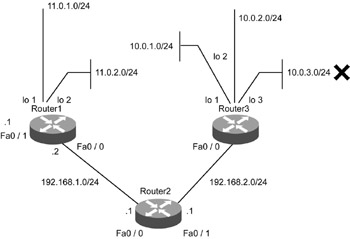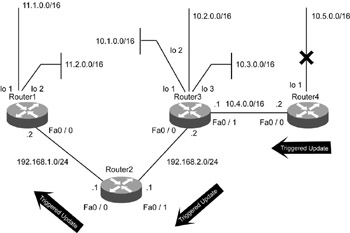Split Horizon with Poisoned Reverse
Split horizon and split horizon with poisoned reverse have common objectives of avoiding reverse routes and ensuring a loop-free routing environment. The difference is in the way they craft their update packets. In case of split horizon with poisoned reverse, the router resends the information about the networks on the interface, including the networks that were learned from the updates received on that interface. This is done by marking the route unreachable when the information is sent back to the direction from which it was received.
Table 6.8 shows the split horizon with poisoned reverse update packet format broadcasted by Router3 on its interface fa0/1.
| Routes | Metric | Status |
|---|---|---|
| 192.168.2.0 -> Directly connected | Will be sent | |
| 10.0.1.0 -> Directly connected | Will be sent | |
| 10.0.2.0 -> Directly connected | Will be sent | |
| 10.0.3.0 -> Directly connected | Unreachable | Will be sent |
| 10.0.4.0 -> Directly connected | 1 | Will be sent |
| 192.168.1.0 ->via 192.168.2.1 | Unreachable | Will be sent |
| 10.0.5.0 -> via 10.0.4.2 | 2 | Will be sent |
| 11.0.0.0 -> via 192.168.2.1 | Will be sent |
The update packet broadcast from Router4 on its interface fa0/0 will carry information about all the networks. Only the networks that were learned from the update packets sent by Router3 will be marked as unreachable. This is shown in Table 6.9.
| Routes | Metric | Status |
|---|---|---|
| 10.0.4.0 -> Directly connected | Unreachable | Will be sent |
| 10.0.5.0 -> Directly connected | Will be sent | |
| 192.168.2.0 -> via 10.0.4.1 | Unreachable | Will be sent |
| 10.0.1.0 -> via 10.0.4.1 | Unreachable | Will be sent |
| 10.0.2.0 -> via 10.0.4.1 | Unreachable | Will be sent |
| 10.0.3.0 -> via 10.0.4.1 | Unreachable | Will be sent |
| 11.0.0.0 -> via 10.0.4.1 | Unreachable | Will be sent |
Route Poisoning
Route poisoning reduces the convergence time when a particular route fails. As per the standard response, if a particular route to a destination fails, it is immediately removed from the routing table. Similarly, other neighboring routers in the network will remove the route when they note the failure of the route via the routing update packet received by them. Route poisoning sets the distance of the failed route to infinity on the next routing update, and all the neighbor routers immediately track that the route has become inaccessible.
| Note | Depending on the network size, it can take more time to converge all the connected routers. |
Figure 6.9 shows unavailability of one of the networks connected to Router3 for the understanding of route poisoning.

Figure 6.9: Unavailability of one of the networks connected to Router3 for the understanding of route poisoning.
As shown in Figure 6.9, if network 10.0.3.0 connected to Router3 fails, instead of removing this entry from the routing table, Router3would mark that particular route as inaccessible and update its directly connected routers. This ensures faster convergence in the network.
Triggered Updates
Using this technique, whenever there is an addition or a modification (increase or decrease in the metric value) in the existing routes of the routing table, routers will immediately broadcast their updates without waiting for their update timer to expire. The triggered updates differ from the normal updates by not waiting for the timer to expire. They just send the changed information rather than the entire routing table. This significantly reduces the time required for reconvergence and does not affect the normal timed updates. Figure 6.10 depicts the mechanism of the triggered update.

Figure 6.10: Mechanism of the triggered update.
As shown in Figure 6.10, if network 10.5.0.0 connected to Router4 fails, Router4 will immediately send this update on interface fa0/0. After Router3 receives this information, it will update its routing table and send the update via its interface fa0/0 without waiting for the update timer to expire and will go on until Router1 synchronizes its routing table. This technique reduces the processing time and optimizes the bandwidth use.
Hold-down Timers
Unlike triggered updates, the hold-down timer shows resistance to the immediate topology change. This method ensures some consistency of the routing information by reducing the acceptance of any inconsistent routing information. The hold-down timer is active for a particular route in which the router receives the update for that route with an increased metric value. After the hold-down timer expires, the router will accept the route with the increased metric value and update its routing table. The advantage of this timer is that it prevents routes from being advertised as having failed when the interface is flapping and, therefore, prevents other routers from recalculating their routing table. In addition, this introduces some amount of latency in the total convergence time. This prevents any false information from being propagated in the network.
The command to configure the hold-down timer is shown in Listing 6.54.
Listing 6.54 Command to Configure the Hold-down Timer
Router#conf t Router(config-router)# timers basic hold-down <time in seconds>
EAN: 2147483647
Pages: 130